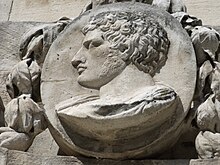Craeperian consul
| Consul | |
|---|---|
Caeso Sexto Calvino, the longest serving elected consul (182, 193–204, 215–216) | |
| Type | Head of state (109 BC – 292 AD) Royal advisor (292 AD – 10th century) |
| Member of | Craeperian Senate |
| Appointer | Elected by citizenry (until 300 AD) Appointed by king (from 300 AD) |
| Term length | 1 year (until 359 AD) 5 years (359 AD – 537) No term length (from 537) |
| Formation | 1 January 109 BC |
| First holder | Gnaeus Servilius Geminus Tullius Arsinius Burrus |
| Final holder | Juan Sánchez León (last confirmed office holder) |
| Abolished | 10th century AD |
A consul was the highest elected office of Craeperia Citerior, the Craeperian Republic, and for its early years, the Kingdom of Craeperia. Two consuls were elected every year and served together throughout the year for which they were elected to serve. Throughout the existence of Craeperia Citerior and the Craeperian Republic, the consuls were the joint-heads of state; during the early years of the Kingdom of Craeperia, the consuls were advisors to the king.
The office of consul was established in 109 BC by Dictator Gnaeus Servilius Geminus to emulate the same government structure of the Romanyan Republic which was led by two consuls. The structure of the consulship was almost identical to that of the Romanyan Republic. Until 292 AD, the only individual who outranked and held more power than the consul was a dictator, a position bestowed by the Craeperian Senate to an individual during times of national emergency. After the fall of the republic in 292, the consulship became an advisory institution to the king, and the king himself generally held one of the consular positions. In 300, elections were abolished and all consuls were appointed by the king. The consulate survived the 745 fall of the Kingdom of Craeperia to the Caliphate of Deltino and was retained under the Emirate of Rabadsun. The office of consul disappeared sometime during the 11th century when the last consular appointment was recorded in 1011.
Prior to 300, all Craeperian citizens over the age of 40 who were previously elected as praetors were eligible to be elected consul as long as they had not been elected to the office in the prior ten years. After one's consulship, they would generally receive the title of proconsul and be awarded a province to command. In the event that a consul dies in office, is removed from office, or resigns from office, a special election was held to elect a suffectus consul to serve the remainder of the consular term. After 300, the requirement for one to have been elected as a praetor was amended to simply having been appointed as a praetor by a consul or the king. In 359, terms for consuls was extended to five years, and in 412, one of the consulate positions was eliminated. In 537, term lengths for consuls were abolished entirely, and most consuls generally served for life once appointed or until removed by the king.
